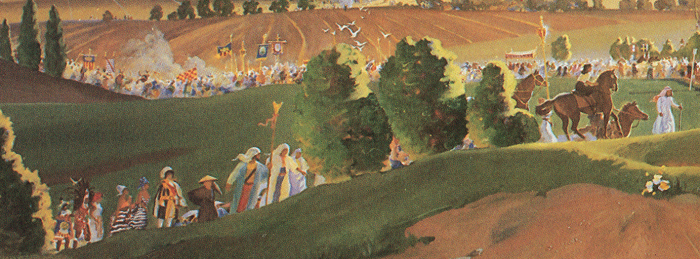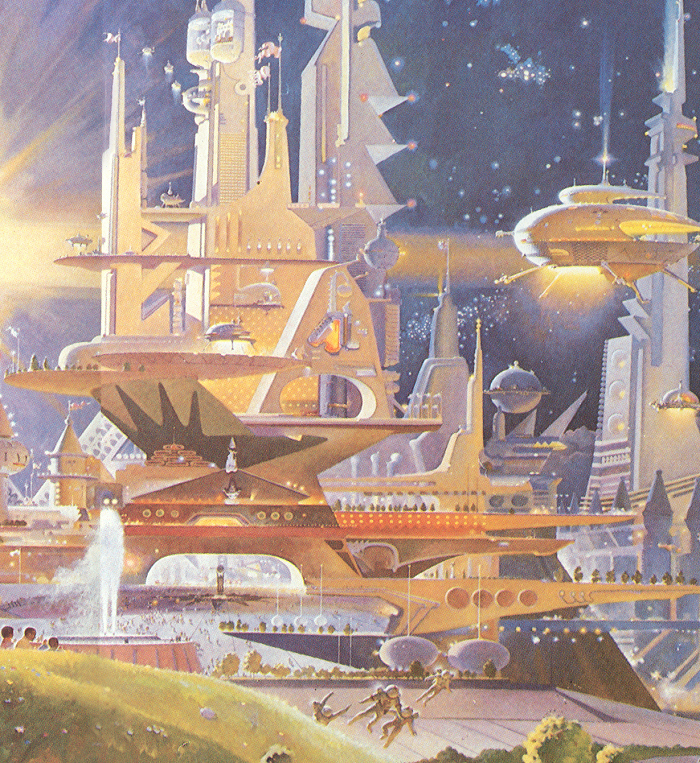
Robert McCall’s “The Prologue and the Promise”
I was unfamiliar with the name Robert McCall when I first stumbled upon “The Prologue and the Promise,” the mural he painted for Disney Epicot’s Horizons attraction in 1983, but I was very familiar with his visionary artwork. His imaginative futuristic designs feature in 2001: A Space Odyssey, Star Trek: The Motion Picture, and numerous NASA conceptual artworks envisioning future habitats for humanity.
His mythic painting of human past, present, and future has never lost its breathtaking effect on me since discovering it a few years ago. I once posted the mural to a forum of scientists sharing their favorite paintings with the caption “closest thing I have to religion.” I was moved when another community member solemnly replied, “I just learned something about myself.”
The reply reminded me of my own experience in discovering I was a humanist. I had a vague sense what I believed but had never heard it articulated until authors like Carl Sagan and Kurt Vonnegut made me aware there was a community of people who believed in their fellow human beings. I strongly suspect the world is full of humanists, people believing in the power of our human collective to achieve great things through science, reason, and progress. It’s just that so many of us don’t realize it. Humanism is an ever-evolving belief system that depends on a myriad of diverse voices trying to express and define it.
That’s why I find McCall’s mural so powerful. Without words it inspires me more than the best prose. It sums up in one single epic image the Humanist worldview, our appreciation for all who have come before us and our optimism for a better future.
March of Ancestors

March of Ancestors
Leading into the foreground is the key element of this piece. We see a long line of people heralding from different times and cultures. They carry banners, sport a wide variety of cultural attire, and parade out of the past into the present. There are signs of conflict in the distance, the smoke of wars obscuring the people, leaving only their flags visible. The line is obscured at other points as well, hidden behind trees and hills, just as parts of human history are lost to us.
Seeing this line, I’m struck with an immense sense of gratitude. None of the syntropic elements of this painting are possible without human beings. These people carried us to the present. They were responsible for our survival and progress. Each of their minor contributions, whether novel inventions or raising children, accumulated into the 7 billion-strong majesty of modern civilization. Civilization truly is a relay race.
Monument Mile Markers

Artifacts of Civilization
In the distance behind the march of ancestors are the artifacts, in the strict ‘made by humans’ sense, of civilization. The Pyramids, Parthenon, Incan Temple, Teepees, Taj Mahal, Eiffel Tower, symbols for Shinto and Buddhist philosophies, Red Square, Washington Monument, United States Capitol Building, and many other monuments of civilization set down all around the world. We are reminded that progress comes from all corners of the globe and all cultures.
McCall demonstrates a deep and broad understanding of where we have come from with all these icons. I especially appreciate the detail of the hot air balloons, the technical innovation from which we could begin to see just how big our world is and our tiny place in it. Conversely, underneath the dark clouds on the left are the most important artifact of all: the row crops of agriculture. It was here that humanity set down its roots and permanent communities could form over ten millennia ago. All of these are signposts in humanity’s journey.
In the Now

Family Standing in the Present
At the precipice between past and future, standing at the horizon of the present, is McCall’s own family. We cannot see their faces, but we can feel their sense of awe and wonder at the utopia ahead. We are standing there with them in this moment in time.
While the vision of the future is fantastic to us, it will be mundane to those living in it. That is the irony of progress. We can cross the skies in planes, enjoy a bounty of foods and luxuries from around the world, and work magical incantations with programming code to supplement our daily lives, but we take it all for granted. Nearly every generation lives in an age of wonder compared to the generations before it, and my fear is that if we lose sight of this fact we will fall prey to nostalgia-inspired recidivism in search of some non-existent “golden age.” As McCall’s epic mural profoundly conveys, our golden age always lies before us.
The Future and Beyond

The Shining Future
The line of ancestors into the future is even more obscured than that of our past, but I love the tiny glimpse of humans in space suits starting to float away from Earth. Like the ancestors marching with domesticated horses, our decedents will have new fantastical means of locomotion. The palace of the future is a towering, majestic, and–most importantly–alien thing. Just as our modern world of technological wizardry is often alien to our elders. We can imagine our daily lives would grow increasingly incomprehensible to our ancestors the further back we travel in time.

Distant Future
The dark clouds on the left open into blue skies–and eventually crystal-clear views of space. Once subject to the whims of weather, the human race breaks free of its gravity well chains and sets out to new worlds and possibilities.
This is the religious portion of the mural for me. Just as theists have faith in the supernatural, I keep faith in a better future for myself, my children, and my human race. I don’t have a choice in the matter. The alternative is unconscionable. I faithfully go to work each day, support my charities, and make my tiny contribution to the progress of our global civilization. I worship at the altar of a better world and find my meaning in helping to realize it, and I regularly meditate on McCall’s “Prologue and the Promise” to reinforce that.
Further Reading
You can download a high-resolution version of “The Prologue and the Promise” from ImagineeringDisney.com.
You can find a large collection of McCall’s many other inspiring works at McCallStudios.com. For another of his epic works, enjoy A Tour of the Universe, Arizona’s largest mural featured at the Challenger Space Center in Peoria, AZ.